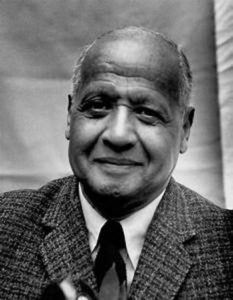
Roy DeCarava
*Roy DeCarava was born on this date in 1919. He was a Black artist and photographer.
Roy Rudolph DeCarava was born in Harlem, New York, the only child of Elfreda, a Jamaican, and Andrew DeCarava. At five, he began to express his artistic ability: he made jewelry with his friends, chalk drawings in the streets where he played, and sketches of "cowboys and Indians.” From early childhood through high school, he shined shoes, sold newspapers on the subway, made deliveries, or hauled ice. DeCarava attended the segregated Textile High School's annex in Harlem.
Black students learned nothing, while white students attended the main Textile High on 18th Street in New York and learned to design and manufacture textiles. After a year at the annex, he and a friend, Alfonso Merritt, transferred to the maprimarychool as the only Blacks. There, DeCarava studied art history and was introduced to the works of Vincent Van Gogh, Michelangelo, and Leonardo da Vinci, developing an informed sense of art. He graduated in 1938 and passed an examination to attend The Cooper Union School of Art, where he studied art for two years.
Frustrated with the constant racism between home and school, DeCarava left Cooper Union in 1940. He turned to photography that year and quickly mastered the requirements of the small, hand-held camera, the trademark of advanced American work. DeCarava shot and developed many pictures after winning a Guggenheim Fellowship in 1952, the first awarded to a Black photographer. This allowed him to spend an entire year photographing daily life in Harlem. His pictures brought a new gentleness and intimacy to photography. Among his earliest works exhibited are photographs that first appeared in the book The Sweet Flypaper of Life (1955), with a fictional text by Langston Hughes.
That same year, DeCarava opened a photographer's gallery in New York, a pioneering effort to win recognition for photography as fine art. The gallery remained open for more than two years. In 1956, he embarked on an extensive series of photographs of jazz musicians John Coltrane, Billie Holiday, and more. Together with photos of Langston Hughes, Paul Robeson, Norman Lewis, and others, these formed substantial work. DeCarava quit his job as a commercial illustrator in 1958, and for most of the next two decades, he earned his living as a freelance photographer.
In the early 1960s, DeCarava's work grew more tough-minded, responding to racial discrimination. He shot the laborers in New York's garment district and civil rights protests, Mississippi freedom marchers in Washington, D. C., and other moments in eastern America. In 1963, he helped found the Kamoinge Workshop, an association of African American photographers based in Harlem. In 1975, he began to teach photography at Hunter College, where he is a distinguished Professor of Art at the City University of New York. A lifelong New Yorker, DeCarava has almost always been photographed close to home. His art continued to evolve.
DeCarava's hand-camera style discards artificial light as an intrusion upon experience, thus accepting deep shadow and blur as marks of legitimacy. Beginning in 1985, DeCarava elaborated this principle in pictures whose long exposures make the blur of motion an active stylistic device. His style and work continue into the twenty-first century. Roy DeCarava died on October 27th, 2009.
A History of African American Artists from 1792 to present
by Romare Bearden & Harry Henderson
Copyright 1993 by Romare Bearden & Harry Henderson
Pantheon Books, NY
ISBN 0-394-57016-2